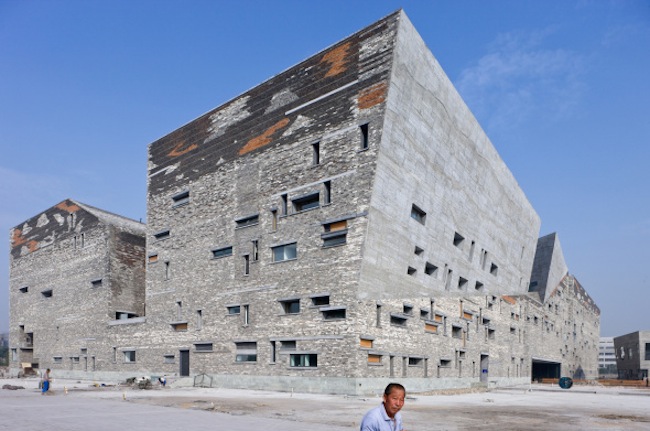The Ningbo History Museum is one of the signature projects of Wang Shu, an architect who was not widely known until he received the 2012 Pritzker Prize, architecture’s equivalent of the Nobel Prize. The Ningbo Museum is located on the west side of Jinzhou central plaza, in the town of Ningbo in Zhejiang Province. The town is both old and new. It was first established 5,000 years ago but has recently been rebuilt as a new and modern but sparsely occupied city.
Faced with a city that had not yet grown into its modern identity, Wang Shu (whose studio is named Amateur Architecture) decided to draw from traditional inspiration: mountains and water. Then he married these concepts to a traditional Chinese building technique called wa pan. This adaptive building technique uses found material fragments, mainly ceramic brick and tile and was developed by the region’s farmers to speed up reconstruction after damage from typhoons.
In an interview with Brendan McGetrick in Domus, Wang Shu admits that “When we first won the competition, some people were very, very angry. They said, ‘In the new, modern district you designed such an anti-modern building!’ but I think that’s not correct.”
“Large stretches of the building’s facade are composed of fragments of various sizes, shapes and materials,” McGetrick writes, “and after a brief appraisal, the architect began to annotate. He pointed to a grey brick about 20 centimeters wide. ‘This one was produced over 400 years ago – that’s the Ming Dynasty. That is a very standard size. This one is from the Qing Dynasty. Some people have found older ones. The oldest one is from the Tang Dynasty – that’s 1,500 years ago.’”
Most of the Ningbo Museum’s exterior is composed of debris collected from destruction sites around the region. Wa pan is a building style that is capable of accommodating a seemingly unlimited variety of source material, a system perfectly suited to the ill-fitting, mismatched pieces with which Wang had to work. Though he had used this technique previously in his campus for China Academy of Arts in Hangzhou, the Ningbo Museum offered the first chance to apply wa pan in its place of origin.
“Only the craftsmen in this area know how to do this,” Wang told McGetrick. “But if we don’t use it in modern architecture I think the craftsmen will forget how to do it. When we started, many couldn’t remember, so we had to use photos and teach them again.” He looked over the empty streets and endangered farmland that surrounds the museum and added, “We call this a ‘no memory area’. In this huge district I found only one traditional village that was intact, and maybe next year it will also be demolished. There is no tradition here. I designed this to try to bring their memory back.”
Garth Clark is the Chief Editor of CFile.
Above image: Architect Wang Shu’s Ningbo History Museum, Ningbo, China. Photograph courtesy of Amateur Architecture Studio.









Architect Wang Shu’s Ningbo History Museum, Ningbo, China. All images courtesy of Amateur Architecture.
Learn more about Wang Shu’s Amateur Architecture Studio
Read Brendan McGetnick’s Interview with Wang Shu


We are wild for these walls!! We love the textural poetry of preservation, artistry, whimsical power and ingenuity! Gorgeous!
I enjoy looking through your site. Thank you!
Ningbo – what an overwhelming impression ! What a sensitive handling of the details ! What an inventive spirit !
The Ningbo Museum is totally fascinating. I suspect the photos tell only a small part of the story of this extraordinary building. It is worth a trip to China!! Thank you for posting this information.
Loving the Cfile…
Astounding building.
we are starting to plan a Nothwest India trip for the spring…
(Any monuments in clay to recommend there?…;-) xx, J/P
I love the past living in a new piece, that a history museum is built of the history it houses. Modern, slab-like and monumentally graceful, this building is undeniably indigenous, arresting, and the Ningbo History Museum is worthy of that 2012 Pritkzer Prize.
Everyone loves
what you guys are up
too. This kind of clever
work and exposure! Keep up the excellent works
guys I’ve added you guys to blogroll.